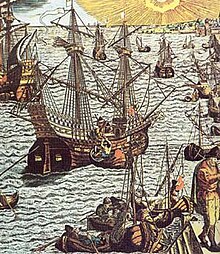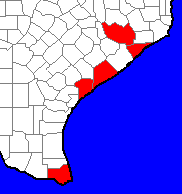
Hurricane Anita was a powerful Atlantic hurricane during the otherwise quiet 1977 Atlantic hurricane season, and the latest first named storm on record since tropical cyclones were first named in 1950. The first tropical cyclone of the season, Anita developed from a tropical wave on August 29 in the north-central Gulf of Mexico. It tracked westward into an area with conditions favorable for further development, and quickly intensified into a hurricane by late on August 30. Initially, Anita was forecast to strike Texas, though a building ridge turned it to the west-southwest. The hurricane rapidly strengthened to attain peak winds of 175 mph (280 km/h), and on September 2 Anita made landfall in eastern Tamaulipas as a Category 5 hurricane. It quickly weakened as it crossed Mexico, and after briefly redeveloping into a tropical depression in the eastern Pacific Ocean, Anita dissipated on September 4 to the south of the Baja California Peninsula. Anita was the first major hurricane to form in The Gulf of Mexico since Hurricane Ethel of 1960.
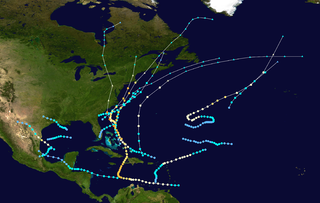
The 1954 Atlantic hurricane season was an above-average Atlantic hurricane season in terms of named storms, with 16 forming. Overall, the season resulted in $751.6 million in damage, the most of any season at the time. The season officially began on June 15, and nine days later the first named storm developed. Hurricane Alice developed in the Gulf of Mexico and moved inland along the Rio Grande, producing significant precipitation and record flooding that killed 55 people. Activity was slow until late August; only Barbara, a minimal tropical storm, developed in July. In the span of two weeks, hurricanes Carol and Edna followed similar paths before both striking New England as major hurricanes. The latter became the costliest hurricane in Maine's history.

The 1945 Atlantic hurricane season produced multiple landfalling tropical cyclones. It officially began on June 16 and lasted until October 31, dates delimiting the period when a majority of storms were perceived to form in the Atlantic Ocean. A total of 11 systems were documented, including a late-season cyclone retroactively added a decade later. Five of the eleven systems intensified into hurricanes, and two further attained their peaks as major hurricanes. Activity began with the formation of a tropical storm in the Caribbean on June 20, which then made landfalls in Florida and North Carolina at hurricane intensity, causing one death and at least $75,000 in damage. In late August, a Category 3 hurricane on the modern-day Saffir–Simpson hurricane wind scale struck the Texas coastline, with 3 deaths and $20.1 million in damage. The most powerful hurricane of the season, reaching Category 4 intensity, wrought severe damage throughout the Bahamas and East Coast of the United States, namely Florida, in mid-September; 26 people were killed and damage reached $60 million. A hurricane moved ashore the coastline of Belize in early October, causing one death, while the final cyclone of the year resulted in 5 deaths and $2 million in damage across Cuba and the Bahamas two weeks later. Overall, 36 people were killed and damage reached at least $82.85 million.

The 1943 Atlantic hurricane season marked the first deliberate reconnaissance aircraft flights into tropical cyclones. The season officially lasted from June 16 to October 31, which was, at the time, considered the most likely period for tropical cyclone formation in the Atlantic Ocean. A total of ten storms from 1943 are listed in the Atlantic hurricane database, and an eleventh system that affected Florida and Georgia has been identified as a probable tropical depression. The first system of the year, dubbed the "Surprise hurricane", caused severe damage throughout Texas and Louisiana in June, partially because information about its approach was censored in the fray of World War II; the storm caused 19 deaths and $17 million in damage. A major hurricane in mid-August produced hurricane-force winds in Bermuda, and several other tropical cyclones throughout the year resulted in strong winds there. In September, a hurricane impacted the western Gulf Coast of the United States, then a tropical storm struck the Mid-Atlantic. The two storms resulted in $419,000 and $20,000 in damage, respectively; one death was attributed to the latter system. In mid-October, a strong hurricane resulted in flooding and damage to crops throughout the Caribbean; after becoming post-tropical, it contributed to moderate impacts across Nova Scotia.

The 1910 Atlantic hurricane season was the period during the summer and fall of 1910 in which tropical cyclones formed in the North Atlantic Ocean. The season was fairly inactive, with only five storms; however, three grew into hurricanes and one became a major hurricane. The season got off to a late start with the formation of a tropical storm in the Caribbean Sea on August 23. September saw two storms, and the final tropical cyclone—Hurricane Five—existed during October. All but one of the storms made landfall, and the only cyclone which remained at sea had some effects on the island of Bermuda.

The 1909 Atlantic hurricane season was an average Atlantic hurricane season. The season produced thirteen tropical cyclones, twelve of which became tropical storms; six became hurricanes, and four of those strengthened into major hurricanes. The season's first storm developed on June 15 while the last storm transitioned into an extratropical cyclone on November 14. The most notable storm during the season formed in late August, while east of the Lesser Antilles. The hurricane devastated the Lesser Antilles, the Greater Antilles, and Mexico, leaving around 4,000 fatalities and more than $50 million (1909 USD) in damage.
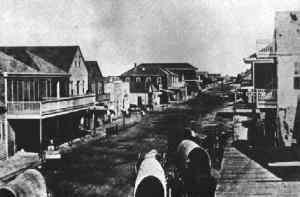
The 1886 Indianola Hurricane was a powerful tropical cyclone that destroyed the town of Indianola, Texas in August 1886, remarkably impacting the history and economic development of Texas. It was the fifth and strongest hurricane of the 1886 Atlantic hurricane season, and one of the most intense hurricanes to ever hit the United States.

Hurricane Claudette was a moderately strong tropical cyclone that struck South Texas in July 2003. A fairly long-lived July Atlantic hurricane, Claudette was the fourth depression, third tropical storm and first hurricane of the 2003 Atlantic hurricane season. Claudette began as a tropical wave in the eastern Caribbean. It moved quickly westward, brushing past the Yucatán Peninsula before moving northwestward through the Gulf of Mexico. Claudette remained a tropical storm until just before making landfall in Port O'Connor, Texas, when it quickly strengthened to a strong Category 1 hurricane on the Saffir-Simpson Hurricane Scale. Forecasting of its path and intensity was uncertain throughout its lifetime, resulting in widespread and often unnecessary preparations along its path.
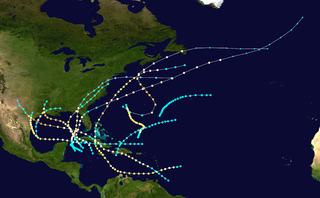
The 1886 Atlantic hurricane season ran through the early summer and the first half of fall in 1886. This is the period of each year when most tropical cyclones form in the Atlantic basin. It was a very active year, with ten hurricanes, six of which struck the United States, an event that would not occur again until 1985 and 2020. Four hurricanes became major hurricanes. However, in the absence of modern satellite and other remote-sensing technologies, only storms that affected populated land areas or encountered ships at sea are known, so the actual total could be higher. An undercount bias of zero to six tropical cyclones per year between 1851 and 1885 and zero to four per year between 1886 and 1910 has been estimated. Of the known 1886 cyclones, Hurricane Seven and Tropical Storm Eleven were first documented in 1996 by Jose Fernandez-Partagas and Henry Diaz. They also proposed large alterations to the known tracks of several other 1886 storms.

The 1885 Atlantic hurricane season ran through the summer and the first half of fall in 1885. This is the period of each year when most tropical cyclones form in the Atlantic basin. In 1885 there were two tropical storms and six hurricanes in the Atlantic basin. However, in the absence of modern satellite monitoring and remote-sensing technologies, only storms that affected populated land areas or encountered ships at sea were recorded, so the actual total could be higher. An undercount bias of zero to six tropical cyclones per year between 1851 and 1885 and zero to four per year between 1886 and 1910 has been estimated.
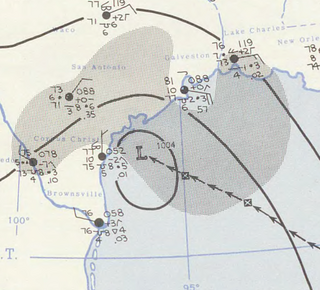
Hurricane Ella brought flooding to the Greater Antilles and Texas in September 1958. The fifth named storm and third hurricane of the annual season, Ella developed from a tropical wave located just east of the Lesser Antilles on August 30. Initially a tropical depression, it strengthened into Tropical Storm Ella six hours later. The system crossed the Leeward Islands and entered the Caribbean Sea late on August 30. Ella headed westward and by August 31, intensified into a Category 1 hurricane. Hours later, it strengthened into a Category 2 hurricane on the Saffir–Simpson hurricane wind scale. The storm curved northwestward while south of Hispaniola and as a result, struck the Tiburon Peninsula of Haiti on September 1. Flooding in that country killed 30 people in Aux Cayes and left 3 other missing. Additionally, thousands were left homeless, about one-third of crops were washed out, and numerous cattle were killed.

Tropical Storm Frances caused extensive flooding in Mexico and Texas in September 1998. The sixth tropical cyclone and sixth named storm of the annual hurricane season, Frances developed from a low pressure area in the Gulf of Mexico on September 8. The cyclone moved northward through the western Gulf of Mexico, making landfall across the central Texas coastline before recurving across the Midwest through southeast Canada and New England. A large tropical cyclone for the Atlantic Basin, yet an average sized system by western Pacific standards, the storm produced heavy rains across the Isthmus of Tehuantepec, Texas, western Louisiana and the Great Plains.

Hurricane Fern was the sixth named storm and fourth hurricane of the 1971 Atlantic hurricane season. It formed from a tropical wave which interacted with a large trough of low pressure to form Fern, as well as Hurricane Ginger, Tropical Storm Heidi, and a system later designated as Tropical Depression Sixteen, which moved into South Carolina. Fern crossed southeastern Louisiana as a tropical depression on September 4 before swinging back out over the Gulf of Mexico. Fern reached hurricane status on September 8, reaching a peak intensity of 90 mph (140 km/h) before making landfall near Freeport, Texas, two days later.

The 1875 Atlantic hurricane season featured three landfalling tropical cyclones. However, in the absence of modern satellite and other remote-sensing technologies, only storms that affected populated land areas or encountered ships at sea were recorded, so the actual total could be higher. An undercount bias of zero to six tropical cyclones per year between 1851 and 1885 has been estimated. There were five recorded hurricanes and one major hurricane – Category 3 or higher on the modern-day Saffir–Simpson scale.

The 1871 Atlantic hurricane season lasted from mid-summer to late-fall. Records show that 1871 featured two tropical storms, four hurricanes and two major hurricanes. However, in the absence of modern satellite and other remote-sensing technologies, only storms that affected populated land areas or encountered ships at sea were recorded, so the actual total could be higher. According to a study in 2004, an undercount bias of zero to six tropical cyclones per year between 1851 and 1885 and zero to four per year between 1886 and 1910 is possible. A later study in 2008 estimated that eight or more storms may have been missed prior to 1878.

The 1933 Cuba–Brownsville hurricane was one of two storms in the 1933 Atlantic hurricane season to reach Category 5 intensity on the Saffir–Simpson scale. It formed on August 22 off the west coast of Africa, and for much of its duration it maintained a west-northwest track. The system intensified into a tropical storm on August 26 and into a hurricane on August 28. Passing north of the Lesser Antilles, the hurricane rapidly intensified as it approached the Turks and Caicos islands. It reached Category 5 status and its peak winds of 160 mph (260 km/h) on August 31. Subsequently, it weakened before striking northern Cuba on September 1 with winds of 120 mph (190 km/h). In the country, the hurricane left about 100,000 people homeless and killed over 70 people. Damage was heaviest near the storm's path, and the strong winds destroyed houses and left areas without power. Damage was estimated at $11 million.

The 1875 Indianola hurricane brought a devastating and deadly storm surge to the coast of Texas. The third known system of the 1875 Atlantic hurricane season, the storm was first considered a tropical cyclone while located east of the Lesser Antilles on September 8. While passing through the Windward Islands. After entering the Caribbean Sea, the cyclone gradually began to move more northwestward and brushed the Tiburon Peninsula of Haiti late on September 12. On the following day, the storm made a few landfalls on the southern coast of Cuba before moving inland over Sancti Spíritus Province. The system emerged into the Gulf of Mexico near Havana and briefly weakened to a tropical storm. Thereafter, the storm slowly re-intensified and gradually turned westward. On September 16, the hurricane peaked as a Category 3 hurricane with winds of 115 mph (185 km/h). Later that day, the hurricane made landfall near Indianola, Texas. The storm quickly weakened and turned northeastward, before dissipating over Mississippi on September 18.

